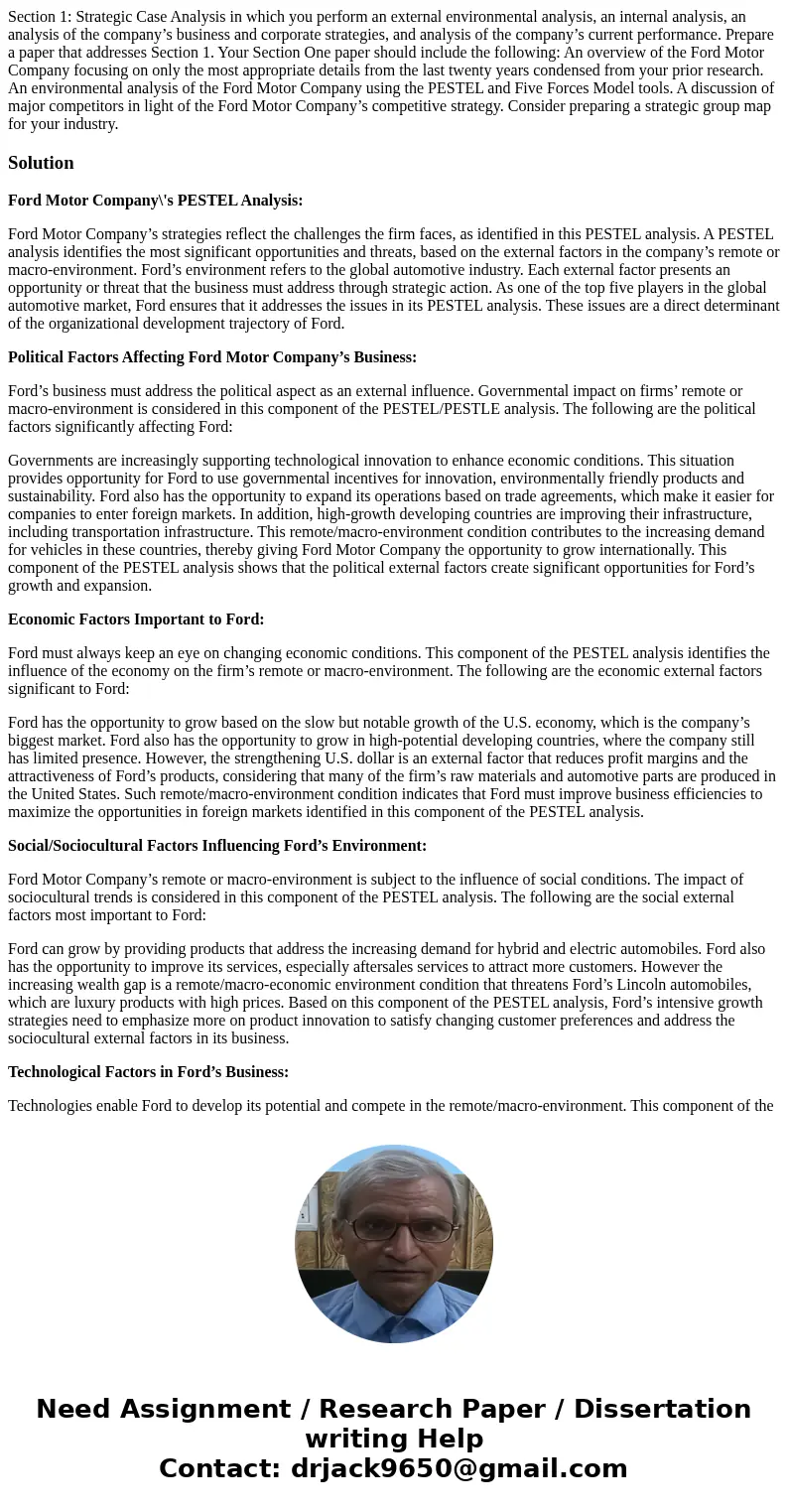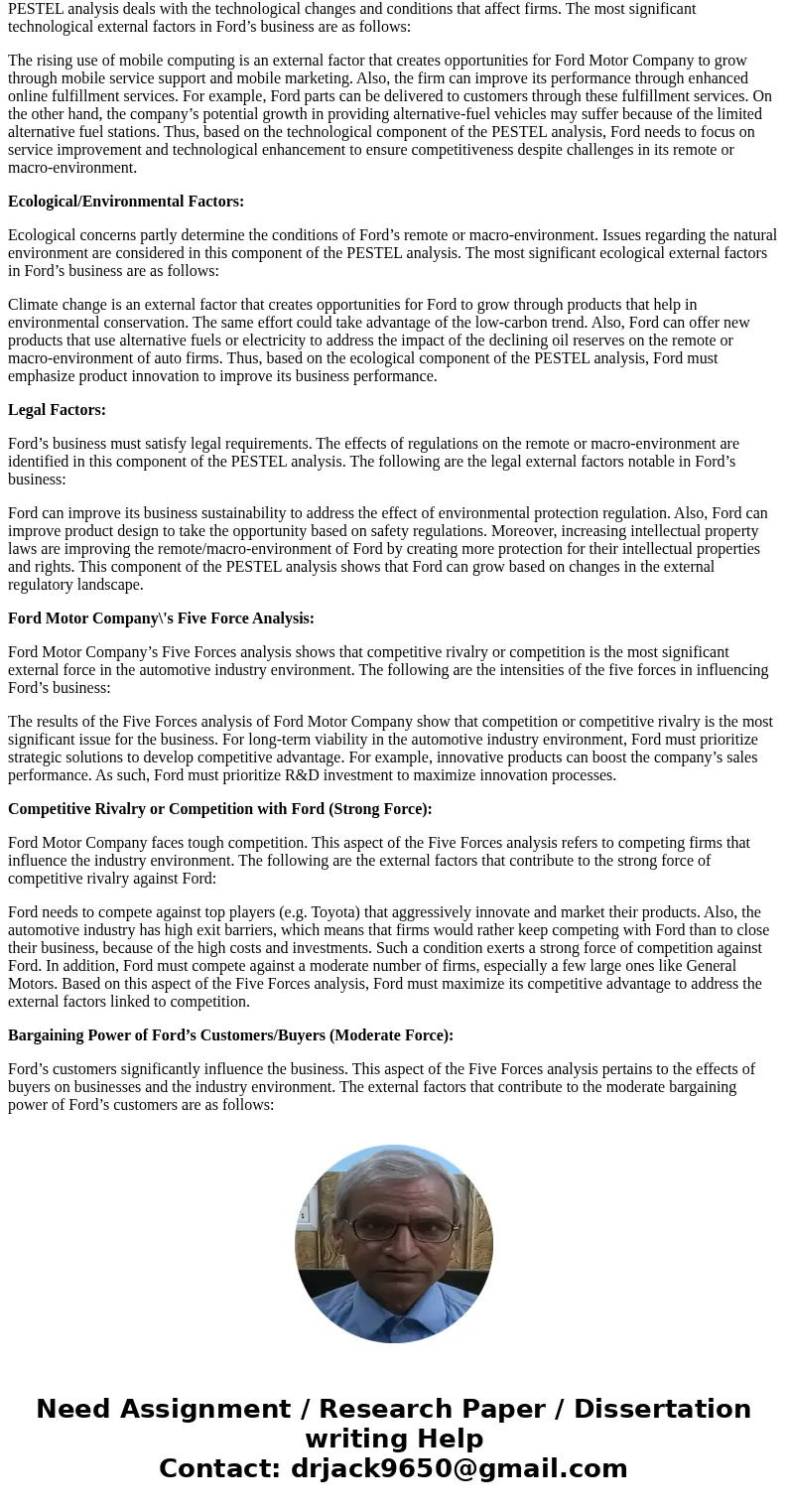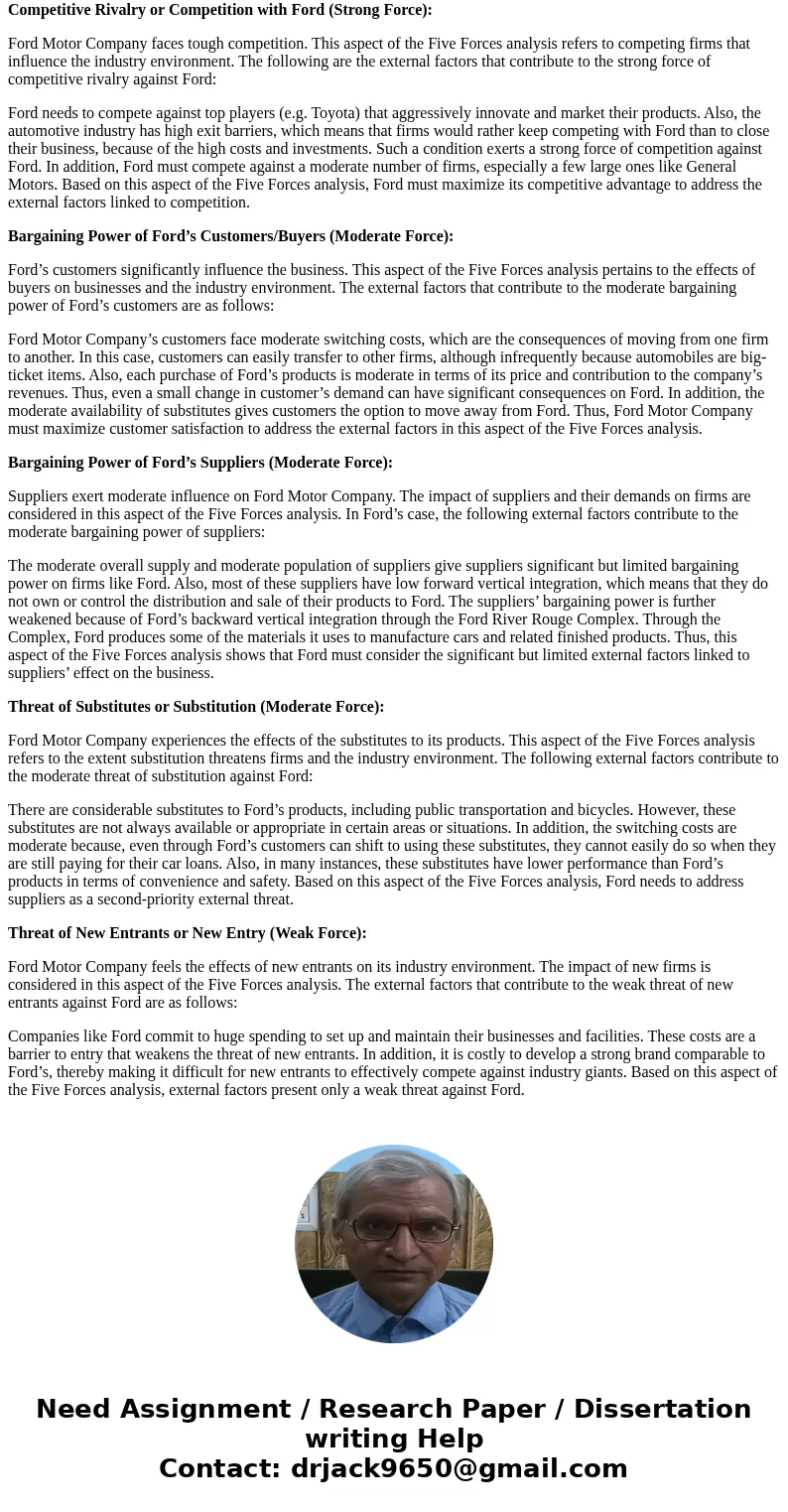Section 1 Strategic Case Analysis in which you perform an ex
Section 1: Strategic Case Analysis in which you perform an external environmental analysis, an internal analysis, an analysis of the company’s business and corporate strategies, and analysis of the company’s current performance. Prepare a paper that addresses Section 1. Your Section One paper should include the following: An overview of the Ford Motor Company focusing on only the most appropriate details from the last twenty years condensed from your prior research. An environmental analysis of the Ford Motor Company using the PESTEL and Five Forces Model tools. A discussion of major competitors in light of the Ford Motor Company’s competitive strategy. Consider preparing a strategic group map for your industry.
Solution
Ford Motor Company\'s PESTEL Analysis:
Ford Motor Company’s strategies reflect the challenges the firm faces, as identified in this PESTEL analysis. A PESTEL analysis identifies the most significant opportunities and threats, based on the external factors in the company’s remote or macro-environment. Ford’s environment refers to the global automotive industry. Each external factor presents an opportunity or threat that the business must address through strategic action. As one of the top five players in the global automotive market, Ford ensures that it addresses the issues in its PESTEL analysis. These issues are a direct determinant of the organizational development trajectory of Ford.
Political Factors Affecting Ford Motor Company’s Business:
Ford’s business must address the political aspect as an external influence. Governmental impact on firms’ remote or macro-environment is considered in this component of the PESTEL/PESTLE analysis. The following are the political factors significantly affecting Ford:
Governments are increasingly supporting technological innovation to enhance economic conditions. This situation provides opportunity for Ford to use governmental incentives for innovation, environmentally friendly products and sustainability. Ford also has the opportunity to expand its operations based on trade agreements, which make it easier for companies to enter foreign markets. In addition, high-growth developing countries are improving their infrastructure, including transportation infrastructure. This remote/macro-environment condition contributes to the increasing demand for vehicles in these countries, thereby giving Ford Motor Company the opportunity to grow internationally. This component of the PESTEL analysis shows that the political external factors create significant opportunities for Ford’s growth and expansion.
Economic Factors Important to Ford:
Ford must always keep an eye on changing economic conditions. This component of the PESTEL analysis identifies the influence of the economy on the firm’s remote or macro-environment. The following are the economic external factors significant to Ford:
Ford has the opportunity to grow based on the slow but notable growth of the U.S. economy, which is the company’s biggest market. Ford also has the opportunity to grow in high-potential developing countries, where the company still has limited presence. However, the strengthening U.S. dollar is an external factor that reduces profit margins and the attractiveness of Ford’s products, considering that many of the firm’s raw materials and automotive parts are produced in the United States. Such remote/macro-environment condition indicates that Ford must improve business efficiencies to maximize the opportunities in foreign markets identified in this component of the PESTEL analysis.
Social/Sociocultural Factors Influencing Ford’s Environment:
Ford Motor Company’s remote or macro-environment is subject to the influence of social conditions. The impact of sociocultural trends is considered in this component of the PESTEL analysis. The following are the social external factors most important to Ford:
Ford can grow by providing products that address the increasing demand for hybrid and electric automobiles. Ford also has the opportunity to improve its services, especially aftersales services to attract more customers. However the increasing wealth gap is a remote/macro-economic environment condition that threatens Ford’s Lincoln automobiles, which are luxury products with high prices. Based on this component of the PESTEL analysis, Ford’s intensive growth strategies need to emphasize more on product innovation to satisfy changing customer preferences and address the sociocultural external factors in its business.
Technological Factors in Ford’s Business:
Technologies enable Ford to develop its potential and compete in the remote/macro-environment. This component of the PESTEL analysis deals with the technological changes and conditions that affect firms. The most significant technological external factors in Ford’s business are as follows:
The rising use of mobile computing is an external factor that creates opportunities for Ford Motor Company to grow through mobile service support and mobile marketing. Also, the firm can improve its performance through enhanced online fulfillment services. For example, Ford parts can be delivered to customers through these fulfillment services. On the other hand, the company’s potential growth in providing alternative-fuel vehicles may suffer because of the limited alternative fuel stations. Thus, based on the technological component of the PESTEL analysis, Ford needs to focus on service improvement and technological enhancement to ensure competitiveness despite challenges in its remote or macro-environment.
Ecological/Environmental Factors:
Ecological concerns partly determine the conditions of Ford’s remote or macro-environment. Issues regarding the natural environment are considered in this component of the PESTEL analysis. The most significant ecological external factors in Ford’s business are as follows:
Climate change is an external factor that creates opportunities for Ford to grow through products that help in environmental conservation. The same effort could take advantage of the low-carbon trend. Also, Ford can offer new products that use alternative fuels or electricity to address the impact of the declining oil reserves on the remote or macro-environment of auto firms. Thus, based on the ecological component of the PESTEL analysis, Ford must emphasize product innovation to improve its business performance.
Legal Factors:
Ford’s business must satisfy legal requirements. The effects of regulations on the remote or macro-environment are identified in this component of the PESTEL analysis. The following are the legal external factors notable in Ford’s business:
Ford can improve its business sustainability to address the effect of environmental protection regulation. Also, Ford can improve product design to take the opportunity based on safety regulations. Moreover, increasing intellectual property laws are improving the remote/macro-environment of Ford by creating more protection for their intellectual properties and rights. This component of the PESTEL analysis shows that Ford can grow based on changes in the external regulatory landscape.
Ford Motor Company\'s Five Force Analysis:
Ford Motor Company’s Five Forces analysis shows that competitive rivalry or competition is the most significant external force in the automotive industry environment. The following are the intensities of the five forces in influencing Ford’s business:
The results of the Five Forces analysis of Ford Motor Company show that competition or competitive rivalry is the most significant issue for the business. For long-term viability in the automotive industry environment, Ford must prioritize strategic solutions to develop competitive advantage. For example, innovative products can boost the company’s sales performance. As such, Ford must prioritize R&D investment to maximize innovation processes.
Competitive Rivalry or Competition with Ford (Strong Force):
Ford Motor Company faces tough competition. This aspect of the Five Forces analysis refers to competing firms that influence the industry environment. The following are the external factors that contribute to the strong force of competitive rivalry against Ford:
Ford needs to compete against top players (e.g. Toyota) that aggressively innovate and market their products. Also, the automotive industry has high exit barriers, which means that firms would rather keep competing with Ford than to close their business, because of the high costs and investments. Such a condition exerts a strong force of competition against Ford. In addition, Ford must compete against a moderate number of firms, especially a few large ones like General Motors. Based on this aspect of the Five Forces analysis, Ford must maximize its competitive advantage to address the external factors linked to competition.
Bargaining Power of Ford’s Customers/Buyers (Moderate Force):
Ford’s customers significantly influence the business. This aspect of the Five Forces analysis pertains to the effects of buyers on businesses and the industry environment. The external factors that contribute to the moderate bargaining power of Ford’s customers are as follows:
Ford Motor Company’s customers face moderate switching costs, which are the consequences of moving from one firm to another. In this case, customers can easily transfer to other firms, although infrequently because automobiles are big-ticket items. Also, each purchase of Ford’s products is moderate in terms of its price and contribution to the company’s revenues. Thus, even a small change in customer’s demand can have significant consequences on Ford. In addition, the moderate availability of substitutes gives customers the option to move away from Ford. Thus, Ford Motor Company must maximize customer satisfaction to address the external factors in this aspect of the Five Forces analysis.
Bargaining Power of Ford’s Suppliers (Moderate Force):
Suppliers exert moderate influence on Ford Motor Company. The impact of suppliers and their demands on firms are considered in this aspect of the Five Forces analysis. In Ford’s case, the following external factors contribute to the moderate bargaining power of suppliers:
The moderate overall supply and moderate population of suppliers give suppliers significant but limited bargaining power on firms like Ford. Also, most of these suppliers have low forward vertical integration, which means that they do not own or control the distribution and sale of their products to Ford. The suppliers’ bargaining power is further weakened because of Ford’s backward vertical integration through the Ford River Rouge Complex. Through the Complex, Ford produces some of the materials it uses to manufacture cars and related finished products. Thus, this aspect of the Five Forces analysis shows that Ford must consider the significant but limited external factors linked to suppliers’ effect on the business.
Threat of Substitutes or Substitution (Moderate Force):
Ford Motor Company experiences the effects of the substitutes to its products. This aspect of the Five Forces analysis refers to the extent substitution threatens firms and the industry environment. The following external factors contribute to the moderate threat of substitution against Ford:
There are considerable substitutes to Ford’s products, including public transportation and bicycles. However, these substitutes are not always available or appropriate in certain areas or situations. In addition, the switching costs are moderate because, even through Ford’s customers can shift to using these substitutes, they cannot easily do so when they are still paying for their car loans. Also, in many instances, these substitutes have lower performance than Ford’s products in terms of convenience and safety. Based on this aspect of the Five Forces analysis, Ford needs to address suppliers as a second-priority external threat.
Threat of New Entrants or New Entry (Weak Force):
Ford Motor Company feels the effects of new entrants on its industry environment. The impact of new firms is considered in this aspect of the Five Forces analysis. The external factors that contribute to the weak threat of new entrants against Ford are as follows:
Companies like Ford commit to huge spending to set up and maintain their businesses and facilities. These costs are a barrier to entry that weakens the threat of new entrants. In addition, it is costly to develop a strong brand comparable to Ford’s, thereby making it difficult for new entrants to effectively compete against industry giants. Based on this aspect of the Five Forces analysis, external factors present only a weak threat against Ford.



 Homework Sourse
Homework Sourse